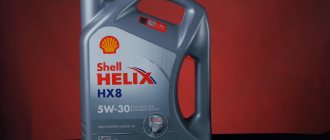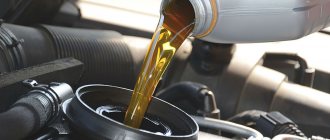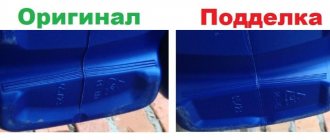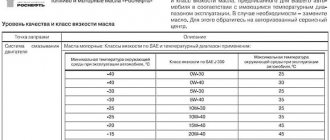— What if the oil you need is not on sale?
— If you decide to try a product from another manufacturer?
— If you bought a used car and don’t know what kind of oil was poured into it before?
In each case, you will need to quickly find a suitable analogue. In order to reduce the likelihood of error, it is better to learn to understand motor oils yourself. To do this, it is enough to know at least the basic details, namely the classification of products according to various standards. In this article, we will decipher one of the most popular types of oils today, 5w40. We will analyze this abbreviation, the meaning of its elements and talk about when it should be poured and what it can be mixed with.
To begin with, let's say that they mean the classification of oils according to the SAE standard. This standard was introduced by the American Society of Automotive Engineers, which later became a major global concern SAE.
Since the standards and methods for producing motor oils changed with the development of the oil industry, the need arose to classify them according to certain parameters. The SAE specification was based on viscosity, or rather its values at low and high temperatures.
As you know, in the cold the oil thickens, and in the heat, on the contrary, it becomes more liquid and fluid. Manufacturers are required to monitor whether the viscosity indicator meets the requirements necessary for proper engine operation. It is necessary that the lubricant simultaneously meet two conditions:
- Easily pumped through the channels of the lubrication system at low temperatures.
- Provided sufficient load-bearing capacity of the protective film at engine operating temperature.
If a product did not meet these requirements, it could not be SAE certified.
Using its influence, the community (its founders included Henry Ford and Andrew Riker) obliged all manufacturers to meet new standards and label their products. This solution proved acceptable to manufacturers from other countries, and SAE soon became international. Of course, the development of the industry did not stop, and the standard adapted to new realities.
Important!
Today you can choose oil according to SAE, regardless of what country in the world you are in. It will meet the same standards.
SAE oil designation
During the technical improvement of engines, oils were also changed. They have evolved from crude oil and animal fats to modern lubricants. Throughout development, the main problem with motor oils has remained viscosity. The advantage of the thick lubricant was the ability to withstand loads in the gaps of hydrodynamic bearings; a significant disadvantage was the problem with engine operation during the low temperature season.
Using the knowledge and technology of their time, manufacturers solved this problem. At the same time, everyone gave their own interpretation to the lubrication parameters, which is why motorists were in difficulty. This state of affairs led to the need to introduce a single standard in the requirements and designations of viscosity values. On this basis, engineers of the American SAE community proposed introducing a classification of motor oils.
Is it possible to mix different 5w40 oils?
Experts do not recommend mixing oils from different manufacturers, even if they have the same viscosity. No one can guarantee the compatibility of products, especially in conditions of different bases (additives and additives, as a rule, rarely “conflict”). The overall characteristics of the resulting fluid will most likely be reduced, which will negatively affect engine performance.
Owners of cars with forced or turbocharged engines should be especially careful.
The safest mixing option involves fluids of the same viscosity from the same manufacturer. Fluidity can be changed in one direction, but this will not have a significant effect on the quality of the lubricant.
Viscosity
The viscosity index depends on temperature. High temperature reduces viscosity and the oil thins, low temperature increases it: the oil thickens. In order for the engine to operate stably without wearing out for a long time, two important requirements are imposed on motor oils:
- pumping through the lubrication system at low temperatures;
- sufficient load capacity of the oil film on a warm engine.
Viscosity designation options
The marking introduced by SAE is still valid today. Using the markings of any manufacturer, the motorist determines for what season and at what temperature the motor lubricant is applicable.
The indexing marks are arranged in AW-B order. Decoding of signs:
- A - a number indicating the degree of frost resistance (the lower the number, the higher the frost resistance), the possibility of pumping oil through the channels of the lubrication system at low ambient temperatures;
- W - the letter adjacent to the first number means “winter” (winter);
- B is a number that determines heat resistance (a higher number means higher heat resistance), maintaining the load capacity of the oil film in the summer heat.
In the marking of summer oils there is only the second digit, in the winter index there is only the first, together with the letter W. The presence of two digital index values indicates the versatility of the oil: in winter and summer, but within the temperatures indicated by the numbers.
Oil 5w40: decoding of the designation
As already noted, deciphering the labeling of all-season oil allows you to determine under what temperature conditions it will show its optimal lubricating effect.
Let's take 5w40 oil, popular among car enthusiasts.
The “5w” element indicates the possibility of pumping the product through the oil channels in the cold season - at temperatures of -30 ° C (5-35).
The number 40 determines the upper temperature threshold of the oil - +40 °C. It is at this temperature (higher is extremely undesirable) that the oil film in a warm engine will retain its load-bearing capacity and will reliably separate the rubbing surfaces.
Thus, oil marked 5w40 is a universal all-season product, capable of operating in the temperature range from -30 °C to +40 °C.
5W-40: decoding
Before proceeding with the analysis, it is necessary to make a reservation about the relativity of the digital values of the marking. Explanation of the 5W-40 lubricant index:
Number 5 is a winter viscosity indicator that helps calculate the pour point when the oil pump pumps lubricant through the system channels without obstacles when the engine is cold.
Calculation: the number 35 is subtracted from index 5: 5 – 35 = – 30. The resulting number is an indicator of frost when the engine works properly during a cold start. This is also the maximum temperature at which engine cranking becomes minimal: the oil thickens in the cold, and the starter’s operation is difficult.
W is a winter designation that is also present in the markings of universal lubricants.
The number 40 is a summer viscosity indicator that helps calculate the maximum positive temperature at which the engine operates, protected from wear by a reliable oil film.
Calculation: subtract 5 from the second number of the index: 40 – 5 = 35. This means that +35°C is the heat limit at which the motor operates stably.
The 5W-40 index indicates the versatility of the oil, i.e. its year-round use. Explanation: when in full working order, the motor can operate uninterruptedly within the temperature range: from – 30° C to +35° C.
Characteristics
When choosing engine oil, you should definitely pay attention to the manufacturer’s recommendations. If the manufacturer has not left recommendations, then you need to adhere to the standard rule. Take winter lubricant taking into account the temperature range characteristic of the area where the car will be operated.
Additives present in the oil can give it the following properties: anti-corrosion, wear resistance, the ability to wash away excess deposits from the engine and counteract oxidation.
Moreover, each additional useful quality leads to an increase in the price of the product. Therefore, when purchasing a lubricant, it is better to choose a product with those properties that a particular engine really needs.
Read more about the main properties of modern machine oil:
- The ability to clean the working surfaces of the motor from various deposits, the formation of which is inevitable during operation. Substances that absorb the surface layer (adsorbents) are responsible for this. They relieve the motor from coagulation (accumulation of small elements).
- Anti-oxidation quality extends the shelf life.
- Lubricity allows moving parts to work as long as possible without abrasion. Oil forms a special film between the rubbing parts.
- Viscosity-temperature parameter. Even if the engine heats up to 190ºС during operation, the viscosity is not lost.
It is strictly prohibited to mix any additives into engine oil yourself. This action can completely damage the motor.
The American SAE system, which is now widespread throughout the world, is quite similar to the GOST adopted in our country. This allows car enthusiasts not to get confused in classification systems.
Also read: 10w40 - semi-synthetic oil for your car engine
The SAE classification tells the consumer the temperature range (on the street) at which the oil is able to provide the engine with crankability, pumpability, optimal lubrication and the absence of dry friction. It is understood that the properties of the oil are fully manifested even at maximum speed and full load mode.
In total, the SAE classification includes 11 lubricants: 6 winter classes and 5 summer classes. “All Season” has the characteristics of both winter and summer lubricants. This is achieved through special additives that allow thickening at elevated temperatures and, on the contrary, not thickening at lower temperatures.
Chemical basis of motor oils
SAE standards relate only to oil viscosity; composition restrictions are not prescribed. The chemical composition of lubricants is not the same; it is determined by the basic basis:
- mineral (petroleum),
- semi-synthetic,
- synthetic.
5W-40 oils can be based on one or another base, and the product receives its properties and features from an additive package.
The disadvantage of mineral-based lubricants is their short service life compared to other options. Advantages of synthetic oils:
- longer service life;
- resistance to heavy loads.
Oil viscosity as one of the most important criteria
The key criteria we use to evaluate an oil is viscosity. The concept of “motor oil viscosity” in simple words can be defined by the level of its fluidity, the thickness of the protective layer remaining on the metal surfaces of the engine. For example, blackstrap molasses has a high viscosity, while water has a low viscosity. It's clear?
In an engine, we essentially want the oil to have dual qualities that are mutually exclusive in nature. We want it to be able to easily flow to critical parts of the powertrain when the vehicle is started, but the protective layer of lubricant should remain sufficiently plentiful while the engine is running at extremely high temperatures, protecting surfaces from abrasion.
The problem is that petroleum-based oil doesn't actually work that way—at least not without some help.
Synthetics and semi-synthetics 5W-40
Synthetic motor oils 5w-40, which have stable technical properties, are recommended for use in expensive cars, as well as racing cars. The use of synthetics significantly extends the replacement period, and it also has excellent cleaning properties.
Semi-synthetic oil is the most popular lubricant. An additive package added to the semi-synthetic base gives it excellent technical characteristics. The price of semi-synthetic lubricant is affordable.
Deciphering automobile oils in the light of world standards
Let’s leave out the specific specifications of automakers, although their presence frees us from the need to study other technical characteristics. Any motor oil has universal characteristics that are suitable for different engines.
What do the numbers 5w40 on the canister mean - video
One of the main characteristics is the SAE viscosity classification.
Brief history of the standard
The abbreviation SAE means a formalized society of automotive engineers, which involves almost all states that are in one way or another connected with the production and mass operation of vehicles.
It was founded in 1905, when it became clear to everyone that the future of transportation belonged to cars. Today, there are more than two and a half thousand standards for the operation of all types of transport and stationary mechanisms.
Understanding them is a real problem for an untrained operator. After all, these standards are valid not only for the personal vehicle we are used to.
Technologies cover public transport, freight vehicles, construction and road equipment, and agricultural implements.
What is SAE in detail - video
The formats, developed by the automotive engineering community and adopted by SAE, create almost 500 working groups accredited in different countries.
In technical forms you can find another name: “J-Reports”. The working groups employ more than 4 thousand certified specialists who have the right to assign international decoding of lubricant designations.
The relevance of the standards has clear objectives that help not only consumers, but also buyers of lubricants:
- setting guaranteed and consistent expectations when using the purchased product;
- compliance with the standards established by international treaties at the expert level;
- compliance with the quality level of produced lubricants;
- guaranteed compatibility of consumables with the units in which they are intended to be used;
- saving money for the consumer;
- reducing costs for the development and production of new products;
- conservation of natural resources, including reducing harm when disposing of lubricants.
Positive results of the activities of the Society of Automotive Engineers:
- for manufacturers – development of uniform standards, prevention of unfair competition (manipulation of imaginary figures of basic characteristics);
- for the consumer - clear and uniform standards for labeling lubricants, by which the product can be instantly identified.
5w-40 vs 5w-30: oil difference
The 5W-30 product is cheaper than 5W-40, so the buyer is looking at a more affordable lubricant and wondering what the difference is between the two options. The difference between them is significant; it concerns the main characteristic of the lubricant - viscosity.
Oil 5w40: decoding
Different viscosities of materials indicate the difference in their temperature limit. The low-temperature indicator of the oils is the same, but the maximum positive indicator of the thermometer differs by ten degrees, and this is a significant difference. What is better than 5W-40 lubricant? It is more reliable and will protect the engine in heat of +35°C.
Applicability of oils
SAE 5W40 class motor oils are used primarily in passenger vehicles, where the crankshaft cranking force is most critical in winter. Such oils are recommended for use in gasoline and diesel engines without a preheater, especially those where the dimensions and capacity of the battery are reduced due to a dense layout.
Produced 5W40 oils can be used subject to additional quality requirements set by car manufacturers and described using API/ACEA quality classes and the corresponding approvals of the plant itself. A list of all conformities is indicated for each type of SINTEC oil. It must be taken into account that SAE 5W40 motor oils do not meet the requirements of engines designed for energy-saving oils.
In such engines, in order to minimize mechanical friction losses, among other things, the elasticity of the compression and oil scraper rings is reduced, which is why they cannot effectively remove the oil film formed by lubricants with high-temperature viscosity SAE 40 and higher.
For “energy-saving” oils, this index does not exceed SAE 30, and additional requirements are introduced in accordance with the ILSAC GF-5 standard. Filling such an engine with conventional SAE 5W40 oil can lead to a significant increase in waste consumption and a decrease in the service life of the catalyst due to the abundant ingress of oil combustion products into it.
Top 10 5W40 motor oils
When choosing a good lubricant that protects a car engine, a rating list is useful, which provides a list of the best brands of 5W-40 motor oils.
| Manufacturer | Oil | Price, rub.) | Rating |
| Netherlands | Shell Helix Ultra | 2 600 | |
| Russia | Lukoil Lux | 1 100 | |
| Germany | Liquid Moli 5W40 Synthoil High Tech | 3 500 | |
| Japan | IDEMITSU Zepro Racing | 3 000 | |
| France | TOTAL Quartz 9000 | 1 600 | |
| USA | MOBIL Super 3000 X1 | 1 800 | |
| Great Britain | Castrol Edge | 2 500 | |
| Germany | Liquid Moly Molygen New Generation | 3 000 | |
| Belgium | XENUM WRX 7 | 10 000 | |
| France | Motul 8100 X-clean | 3 500 |
Number from end
The next number indicates the viscosity of the oil when the engine is warm and running. It will, of course, be higher.
P. _ S. _ Oils with different viscosities are developed on the basis of the “base” engine oil by adding various additives to operate the oil when the engine is warm and protect its components for a long time without changing the lubricant.
Synthetic versus regular mineral oil. Which one should I fill?
Synthetic oils differ from conventional mineral oils in that conventional oils are a refined product of crude oil, while synthetic oils are a product obtained through additional distillation (purification) at the molecular level. This helps separate impurities from the oil and allows the manufacturer to “tailor” the desired set of molecules in the final product.
Performing all this molecular juggling is known as the Fischer-Tropsch process and is beyond the scope of this applied article. But it is with its help that oil with much better mechanical properties at extreme temperatures is obtained.
As for what kind of oil you should use for your car, let's say this: the best answer to this is the car manufacturer itself, which in the manual specifically described the types of motor oils preferred for a specific car model with a specific engine type.
From garage stories from automotive old-timers, I understand that older, simpler engines often use thicker lubricants. As for modern cars, the principle is the same: open the instruction manual and see which engine oil is suitable for the car .
Let us also note the well-known fact that synthetic oil does its job better than mineral oil even after it has practically exhausted its service life. Also, “synthetics” are capable of changing viscosity in relation to nominal values, which conventional oil is not capable of.
See also: How to choose the right engine oil for your car?
Let's say a few words about the possibility of switching from mineral to synthetic oil. Like, you can’t do this: the oil channels will become clogged, the oil will curdle, and synthetics will lose their properties after you pour it into the engine after mineral water. In fact, it is possible to replace one type of oil with another. But! This should not be done for fundamental reasons. Modern car engines will not tolerate topping up or a complete change to mineral water; they are not designed for it. The result is premature failure and expensive repairs. And old engines are sometimes so “leaky” that oil oozes out of all the cracks. You can’t get enough of expensive “synthetics” for them.
By the way, if an emergency occurs and you have no other oil in the store other than mineral oil (which is very unlikely), experienced auto mechanics advise it is better to add it even to a modern engine than to go to the repair site with a minimum oil level in the crankcase. Then the oil should be replaced with new one.











